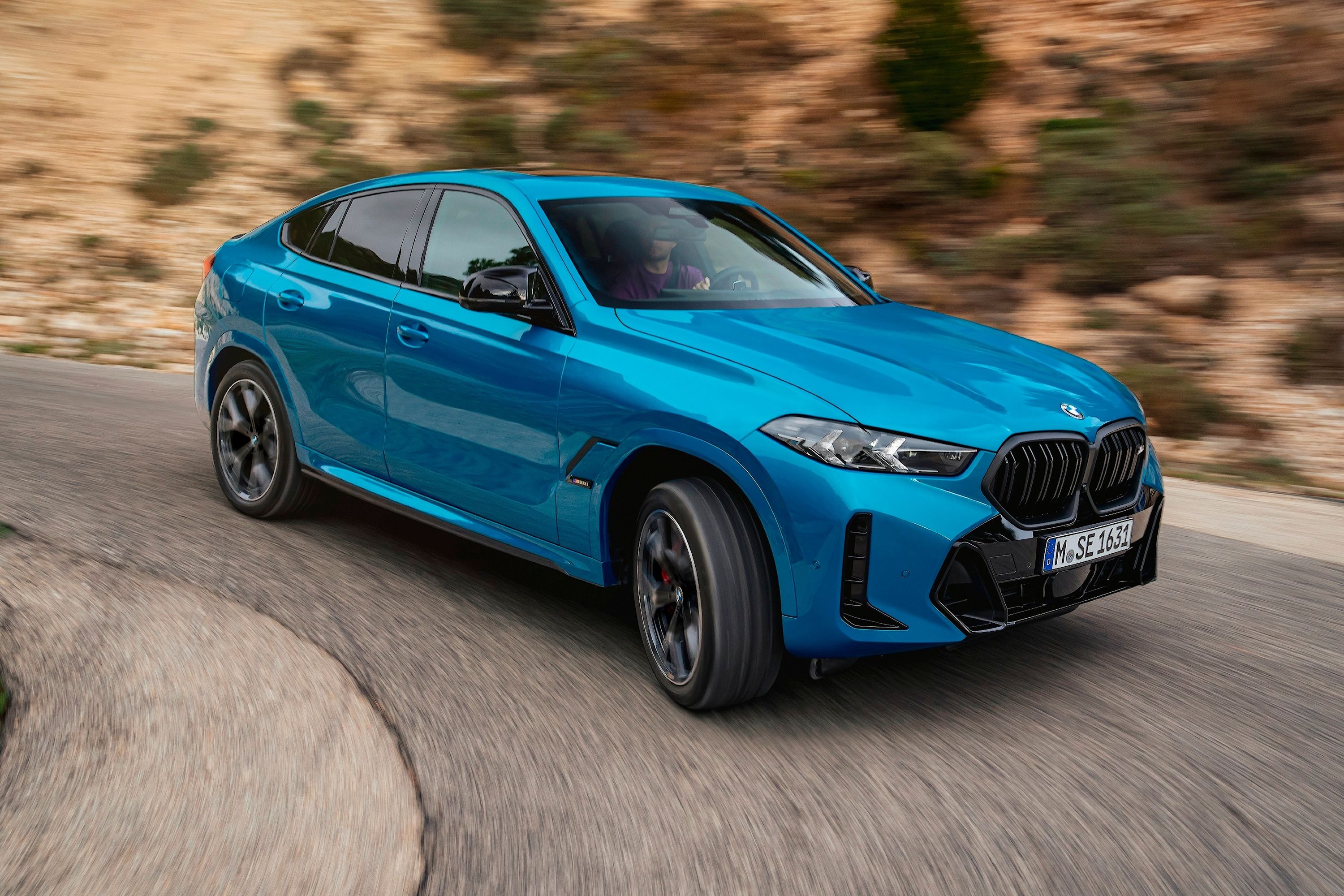
By 2007, BMW had already decided that the world was crossover-hungry enough that it could put a "sportier" version of its X5 mid-size SUV on the market and let the sales numbers do the talking. And so they have, with BMW never producing less than 30,000 $60k-plus X6s per year since 2009. What that kind of enthusiasm means is that BMW has already sent the current F16-generation X6, the second rendition of the SUV that came online in 2015, to the engineering department so that improvements could be made.
And now X6 fans can rejoice over the fact the updated model is finally out. Among the first X6 styling elements to be changed were the F16's Halo headlights, soft yet protruding grille, and subtle front air intakes residing on the fascia. In place of those are BMW's new signature headlamps, which feature four angular LED light strips arranged as a partial hexagon, an enlarged kidney grille that introduces BMW's new grille illumination feature, and much more imposing front air intakes beneath those nostrils.
The hood's creases also get deeper, while the side features smoother yet more pronounced lines that head south, over standard 20-inch wheels that can be optioned up to 22 inches, and meet a new aerodynamic rear lip created by space left over from looks like a smushed-in roof.
And just as it looks, the new X6 is actually lower than the outgoing model, by 0.7-inches, while its footprint gets larger thanks to an extra inch of overall length, 1.6 inches of added wheelbase, and a 0.6-inch increase in width. That helps handling due to the lowered center of gravity, of course, but it also gives designers more freedom to let the roof rise and fall more gradually (like a real coupe) as well as make room for the X6's double-bubble rear hatch glass and subtle twin spoilers that sit above it.
The rear end is a lot to digest, with L-shaped LED taillights following the 8 Series' aesthetic and adding more spice to the already-busy and upward-sloped rear end. Inside, the X6 gains a panoramic glass roof with a surface that's 83% larger than the one on the outgoing model. BMW's optional Panorama Sky Lounge, meanwhile, illuminates 15,000 graphic points in the glass roof in one of six colors to mimic a starlit sky.
Aside from that stylistic changes are evolutionary, with two 12.3-inch screens up front taking the place of the instrument cluster and center-mounted infotainment system and the rest of the interior looking similar to the X7's. Ambient lighting now comes standard, while heated/cooled cupholders and glass controls are now optional to help the X6 feel like the technological masterpiece that it is. Upholding that message under the hood is a choice of two powertrain options which, unlike the X5, include a rear-wheel drive sDrive 40i.
That spec uses the same 3.0-liter inline 6-cylinder engine as the all-wheel drive xDrive 40i to send 335 horsepower and 330 lb-ft of torque (an increase of 33 hp and 35 lb-ft over the old model) to the rear wheels rather than all four. Like its xDrive counterpart, the sDrive 40i gets an 8-speed automatic transmission, allowing the RWD SUV to hit 60 mph from a standstill in 5.2 seconds, with the AWD xDrive 40i making the same run in 5.3 seconds.
A V8 version of the X6 with BMW's 4.4-liter turbocharged engine is available in the xDrive M50i model (no standard 50i model available here), also mated to an 8-speed auto and this time making 523 hp and 553 lb-ft of torque. That allows it to hit 60 mph from a stop in 4.1 seconds before it reaches its 130 mph top speed with all-season rubber or 155 mph top speed when equipped with high-performance summer tires. Upcoming X6 M models are expected to keep that same engine, which produces up to 625 horsepower in the M8 Competition.
Despite the M50i model riding a half-inch higher than its siblings, it should still corner well thanks to standard Dynamic Damper Control and an optional Dynamic Handling Package with active roll stabilization and four-wheel steering, though the options aren't unique to the M model. Extra utility can be enabled by optioning the X6 with a height-adjusting and self-leveling air suspension system, while the xDrive 40i can be had with an off-road package, which adds the above-mentioned air suspension system, the M50i's M Sport rear differential, and four off-road drive modes.
Speaking of drive modes, the X6 packs plenty of other electronic aids that can help a driver in a variety of situations. A new one is Back-Up Assistant, which helps a driver reverse out of a tight spot by automatically turning the wheel the same way it was turned when the car was first parked.
And then there's the usual from BMW's suite of driver aids, like adaptive cruise control that can handle stop and go traffic, a lane-keep assistant, a heads-up display with a larger projection field, and the following mouthful: Blind Spot Detection, Rear Collision Warning, Frontal Collision Warning and Pedestrian Warning with City Collision Mitigation.
If you've made it your mission in life to get behind the wheel of the new X6, BMW is going to you wait until November of 2019, when the X6 goes on sale. Expect the Sports Activity Coupe to start at $64,300 for a new 2020 X6 sDrive40i model, $66,600 for the X6 xDrive40i, and $85,650 for the X6 M50i. Pricing does not include the $995 destination charge.
